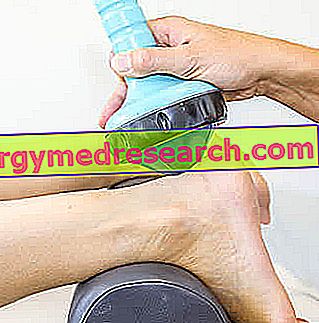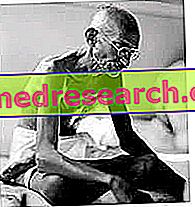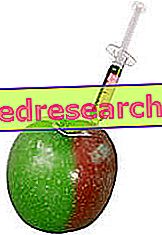Tendon calcification is a tendinopathy; it is a degenerative process that affects the tendons of the striated muscles (especially the larger ones) and which consists in the sedimentation of bone mineral on the surface of the tendon connective tissues.

On the other hand, not all tendinitis causes tendon calcification, but mainly the so-called calcific tendinitis is involved.
The latter is caused by the chronic repetition of slight microtraumas; more rarely it is triggered by acute and close traumatic events (which on the other hand can begin degeneration).
Tendon calcification is responsible for pain, reduced elasticity, impaired mobility and increased risk of breakage.
The areas of the body most affected by tendon calcifications are: shoulder (supraspinatus muscle tendon), Achilles tendon (triceps tendon), knee (femoral quadriceps tendon), elbow (forearm extensors), etc.
Risk factors are mainly behavioral, but individual susceptibility also plays a decisive role.
What to do
- The most important trick is undoubtedly prevention: as we will see below, the possibility of suffering from calcific tendinitis increases by adopting an incorrect lifestyle.
- Recognition of symptoms: the diagnosis is exclusively of orthopedic interest, but early detection of the problem can favor a rapid and positive course:
- Pain in specific movements.
- Palpation pain.
- Sometimes swelling and redness, but they are not indispensable in calcific tendinitis (sometimes they are not even detectable).
- Joint stiffness.
- Limitation of movements.
- Sometimes feeling of joint instability (especially in the shoulder, related to a primary and complex pathological picture).
- Loss of strength.
- Thinning, stretching and fragility of tendons: more than symptoms, they are clinical signs.
- Contact your doctor: after a thorough medical history (functional evaluation, palpation, etc.), the specialist will prescribe one or more diagnostic tests to identify tendon calcification:
- Ultrasound.
- Radiography and Magnetic Resonance: to exclude other diseases with similar symptoms.
- Elimination of the triggering cause: it mainly concerns postural defects, overload stresses, the incorrect technical-sporting or motor execution of customary gestures, the choice of instruments or footwear, the use of work automation, reducing movements and loads, etc.
- WARNING! There are generic pathologies (for example lupus erythematosus) that predispose to the generic onset of tendinopathies. This increases the risk of evolution in calcifications.
- Conservative therapy:
- Rest.
- Support with aids that reduce mobility or improve loading (splints, splints, sticks or crutches, orthotics, etc.).
- Physiotherapy, preventive-rehabilitative gymnastics and stretching: the founder of conservative therapy, they are necessary for the recovery of muscular tropism and eventually of joint stability.
- Cryotherapy (cold therapy): reduces inflammation and pain.
- Drug therapy: non-steroidal anti-inflammatory drugs (NSAIDs) or corticosteroids (more rarely).
- Technological medical treatments (see below): useful for the destruction of calcification and / or the fight against inflammation.
- Surgery: physical removal of calcifications.
- Physiotherapy and rehabilitation.
What NOT to do
- Do not take preventive measures, especially in the presence of:
- Previous clinical history.
- Environmental preparation.
- Family trend.
- Ignore the early symptoms that may be useful for the sudden diagnosis of tendon calcification.
- Do not seek medical attention and try self-care: especially when the discomfort exceeds 8-12 weeks in duration.
- Do not carry out the prescribed diagnostic tests.
- Neglecting the triggering cause by focusing exclusively on reducing symptoms or more generally of the acute phase.
- Use the painful body area normally.
- Do not use guardians or other useful prescribed means.
- To skip or finish physiotherapy early, preventive-rehabilitative gymnastics and all the tricks of conservative therapy.
- Do not perform anti-inflammatory drug therapy prescribed by your doctor.
- Do not perform technological therapies for the destruction of calcifications and the reduction of inflammation.
- Exclude surgery, even if necessary.
- Do not perform rehabilitation and physiotherapy after surgery.
What to eat
- There is no diet suitable for treating tendon calcifications. However, a nutritional deficiency of some molecules could negatively affect healing.
- In tendon calcifications of the lower limbs, if the weight is excessive it becomes fundamental to practice a low-calorie slimming diet. The basic principles are:
- Consume an adequate caloric quantity, or 70% of normal calories.
- Choose foods with a suitable metabolic impact (whole foods and no refined carbohydrates) preventing spikes in blood sugar and insulin.
- Reach a good amount of dietary fiber. It helps keep blood sugar under control, modulates fat absorption and positively affects estrogen levels.
- Keep the fraction of simple carbohydrates no more than 10-16% of total calories (it is sufficient to eliminate all sweet foods while maintaining 4-6 portions of fruit and vegetables, in addition to 1-3 servings of milk and yogurt).
- Keep the fat fraction no more than 25-30% of the total calories, preferring the "good" ones (raw-pressed vegetable oils and medium fat blue fish) compared to the "bad" ones (saturated, hydrogenated, bifractionated, etc.).
- Since tendinous calcification has an inflammatory base, it could be useful to increase the intake of nutrients with a strong anti-inflammatory function:
- Omega 3: are eicosapentaenoic acid (EPA), docosahexaenoic (DHA) and alpha linolenic acid (ALA). They play an anti-inflammatory role. The first two are biologically very active and are found mainly in: Sardinian, mackerel, bonito, alaccia, herring, alletterato, ventresca of tuna, needlefish, algae, krill etc. The third is less active, but constitutes a precursor of EPA; it is mainly contained in the fat fraction of certain foods of vegetable origin and in the oils of: soy, linseed, kiwi seeds, grape seeds, etc.
- Antioxidants:
- Vitaminics: the antioxidant vitamins are carotenoids (provitamin A), vitamin C and vitamin E. Carotenoids are contained in vegetables and red or orange fruits (apricots, peppers, melons, peaches, carrots, squash, tomatoes, etc.); they are also present in shellfish and milk. Vitamin C is typical of sour fruit and some vegetables (lemons, oranges, mandarins, grapefruit, kiwi, peppers, parsley, chicory, lettuce, tomatoes, cabbage, etc.). Vitamin E is available in the lipid portion of many seeds and related oils (wheat germ, maize germ, sesame, kiwi, grape seeds, etc.).
- Minerals: zinc and selenium. The first is mainly contained in: liver, meat, milk and derivatives, some bivalve molluscs (especially oysters). The second is contained above all in: meat, fishery products, egg yolk, milk and dairy products, fortified foods (potatoes, etc.).
- Polyphenols: simple phenols, flavonoids, tannins. They are very rich: vegetables (onion, garlic, citrus fruits, cherries, etc.), fruit and related seeds (pomegranate, grapes, berries, etc.), wine, oilseeds, coffee, tea, cocoa, legumes and whole grains, etc.
What NOT to Eat
- In the case of obesity and tendinous calcifications affecting the lower limbs:
- It is advisable to eliminate junk foods and beverages, in particular fast foods and sweet or savory snacks.
- It is also necessary to reduce the frequency of consumption and the portions of: pasta, bread, pizza, potatoes, derivatives, fatty cheeses, meat and oily fish, salami, sausages and sweets.
- Eliminating alcohol is also crucial: these drinks promote overweight and compromise drug metabolism.
Natural Cures and Remedies
- Stretching: stretching can be static or dynamic, active or passive. In the case of tendon calcifications it serves mainly to combat the consequent joint stiffness.
- Motor exercises for reinforcement: used both in conservative and rehabilitative therapy after surgery. They are particularly useful in calcific tendinitis of the shoulder, in which the triggering cause is very often a reduction in muscle tone, which causes tendon lengthening and consequent rubbing on some bone vertices.
- Cryotherapy: cold therapy is useful in reducing pain and inflammation. It should be performed 2 or 3 times a day. Ice should not be applied directly; on the contrary, it must be placed in a bag containing water and applied by interposing a woolen cloth to protect the skin.
- Tutors, bandages and dressings: these are tools that are sometimes useful for symptom reduction. Their function is to accompany or limit movements. In sporting practice they cannot be very tight; on the contrary, during work it is possible to tighten them more vigorously being careful not to compromise the circulation.
Pharmacological care
WARNING! There are no drugs that can cure tendon calcifications. On the other hand, anti-inflammatory therapy is necessary for the prevention and treatment of tendinopathy that generates calcification. It also plays a pain-relieving role.
- Analgesics: generally also with an anti-inflammatory action, they are used orally mainly in the fight against pain:
- Paracetamol: for example Tachipirina ®, Efferalgan ® and Panadol ®.
- Non-steroidal anti-inflammatory drugs (NSAIDs):
- Systemic for oral use: they are more used than topical ones, as tendon structures can be difficult to reach through cutaneous application (useless for example in the rotator cuff). They are also more powerful than ointments and gels. They may require the use of a gastro protector. Those who suffer from liver or kidney disorders are not always able to take them.
- Ibuprofen: eg Brufen ®, Moment ®, Spidifen ®, Nurofen ®, Arfen ®, Actigrip fever and pain ® and Vicks fever and pain ®).
- Ketoprofen: for example Artrosilene ®, Orudis ®, Oki ®, Fastum gel ®, Flexen "Retard" ® and Ketodol ®.
- Diclofenac: for example Dicloreum ®, Deflamat ®, and Flector ®.
- Naproxen: for example Momendol ®, Synflex ® and Xenar ®.
- For topical use: they are mainly ointments or gels. They have the advantage of acting locally (useful for example on the Achilles tendon) without excessively straining the stomach and liver; however they are less effective. It must be specified that it is not the most suitable pharmacological category and to insist on their use (even in the initial phases) could favor the worsening of inflammation.
- Ibuprofen lysine salt 10% or Ketoprofen 2.5% (eg Dolorfast ®, Lasonil ®, Fastum gel ® etc).
- Corticosteroids:
- they are used only if the oral NSAIDs are not well tolerated for: allergy, gastric ulcer, diabetes etc. If used for long periods they exert many side effects on the connective tissues, in particular on the tendons. They are the most drastic but also the most effective pharmacological solution.
Prevention
- Solicit muscle districts in a natural way, avoiding functional overloads in precarious positions: they can relate to work, hobbies or sport (frequency and intensity of training).
- Use appropriate tools or aids, both in terms of weight and shape and handling.
- Use appropriate footwear.
- Run or jump on regular ground and possibly of intermediate consistency.
- Avoid slippery, too hard (asphalt) or too soft (sand) soils.
- Perform specific movements or sports exercises correctly.
- Avoid taking anabolic steroids to increase muscle mass and strength: they can create an imbalance between muscle strength and tendon resistance.
- Do not abuse local corticosteroid-based injections.
- Carefully warm the body before intense activities.
- Respect recovery and treatment after a tendon injury, to avoid relapses.
- Take a correct posture.
Medical Treatments
- Shock waves (Extracorporeal Shock Wave Terapy): crumble small calcifications, which should be reabsorbed independently. They are based on the localized release of acoustic impulses.
- Tecar therapy: it is a therapeutic method that uses an electric condenser to treat muscle joint injuries and tendinopathies. The mechanism of tecarterapia is based on restoring the electric charge in the injured cells to make them regenerate more quickly.
- Ultrasound: this system uses high frequency acoustic waves. It is very useful as an anti-inflammatory, stimulating edematous reabsorption and to dissolve the adhesions that are formed during healing. It produces heat and increases the permeability of cell membranes.
- Surgery: it is essential when the pain becomes debilitating and the calcifications do not respond to shock wave therapy.
- Physiotherapy: useful both before and after surgery. Optimize functional recovery.



